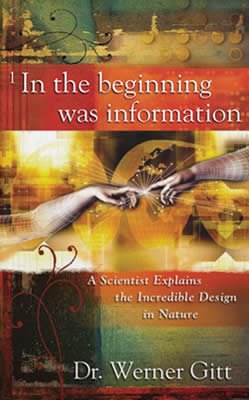
Preface
The topic of this book is the concept of information.
Theme of the Book:
The topic of this book is the concept of information, which is a fundamental entity on equal footing with matter and energy. Many questions have to be considered: What is information? How does information arise? What is the function of information? How is it encoded? How is it transmitted? What is the source of the information found in living organisms?
Information confronts us on all sides; newspapers, radio, and television bring new information daily, and information processing systems are found practically everywhere; for example, in computers, numerical control equipment, automatic assembly lines, and even car wash machines. It should be noted that the activities of all living organisms are controlled by programs comprising information.
Because information is required for all life processes, it can be stated unequivocally that information is an essential characteristic of all life. All efforts to explain life processes in terms of physics and chemistry only will always be unsuccessful. This is the fundamental problem confronting present-day biology, which is based on evolution.
Structure and Purpose of this Book:
This book consists of three main parts and an appendix. In the first part, the nature of natural laws is discussed. This introduction is indispensable for the subsequent formulation and evaluation of information theorems.
The concept of information is clarified by means of many examples in the second and central part of the book. The basic principles are established by means of general theorems which are valid irrespective of the actual discipline. The purpose is to find laws of nature which hold for the fundamental entity known as information. With the aid of such theorems, it becomes possible to formulate conclusions for unknown situations, just as can be done in the case of laws of nature. In contrast to theorems about many other characteristic natural quantities (e.g., entropy), the theorems about information can be clearly illustrated and their validity is easy to demonstrate.
The purpose of this book is to formulate the concept of information as widely and as deeply as necessary. The reader will eventually be able to answer general questions about the origin of life as far as it is scientifically possible. If we can successfully formulate natural laws for information, then we will have found a new key for evaluating evolutionary ideas. In addition, it will become possible to develop an alternative model which refutes the doctrine of evolution.
The topics and theorems developed in the first two parts of the book are applied to the Bible in the third part. This provides a fresh way of unlocking the message of the Bible.
Readership:
The first target group of this book is those who have a scientific inclination; especially information and communication scientists and linguists. The concept of information is highly relevant for these scientists as well as for theologians, and the given examples cover a wide range of disciplines. For the sake of ease of understanding, chapters which contain many formulas are placed in the appendix, and complex relationships are illustrated graphically.
Appendix:
Questions which are closely linked to the concept of information (e.g., Shannon’s theory and artificial intelligence), but would distract the reader’s attention, are discussed in the fairly comprehensive appendix. The concept of energy receives ample attention, because energy plays a similarly important role in technology and in living organisms, as does information.
The Title of the Book:
The title refers to the first verse of the Gospel written by John: “In the beginning was the Word. . . .” This book continually emphasizes the fact that information is required for the start of any controlled process, but the information itself is preceded by the prime source of all information. This is exactly what John has written, since “the Word” refers to the person who is the Prime Cause.
General Remarks:
References to literary sources are indicated by the first letter of the author followed by a serial number, enclosed in square brackets. If there is a “p” and a second number in the reference, this indicates page number(s).
Acknowledgments and Thanks:
After I had discussed the manuscript with my wife, it was also edited by Dr. Martin Ester (München), Dipl.-Inform.; Daniel Keim (München); Dr. Volker Kessler (Vierkirchen), Dipl.-Inform.; Thomas Seidl; and Andreas Wolff. I am sincerely grateful for all their suggestions and amplifications.
Preface to the English Edition
As author, I am delighted that my book is now available in English. Prof. Dr. Jaap Kies (South Africa) was responsible for the arduous task of translating the book into his mother tongue. Dr. Carl Wieland, together with Russell Grigg (Australia), proofread the translation thoroughly. I would like to thank all of those involved for their work in bringing this book into being. May it be a help to those who are seeking and asking questions, as well as to those who already believe.
In the Beginning Was Information
Between the covers of this book may well be the most devastating scientific argument against the idea that life could form by natural processes.
Read OnlineRecommended Resources

Answers in Genesis is an apologetics ministry, dedicated to helping Christians defend their faith and proclaim the good news of Jesus Christ.
- Customer Service 800.778.3390
- Available Monday–Friday | 9 AM–5 PM ET
- © 2026 Answers in Genesis


